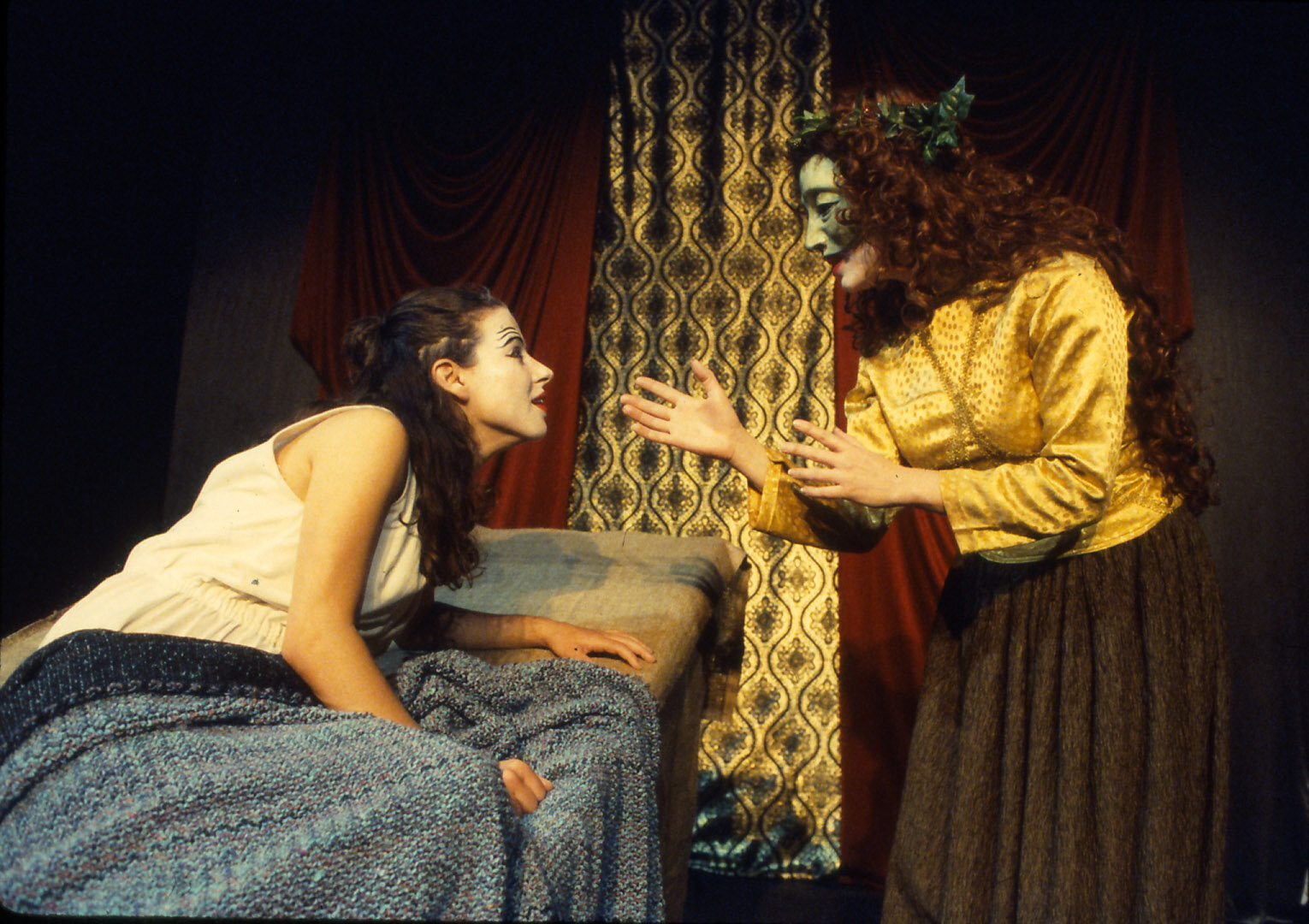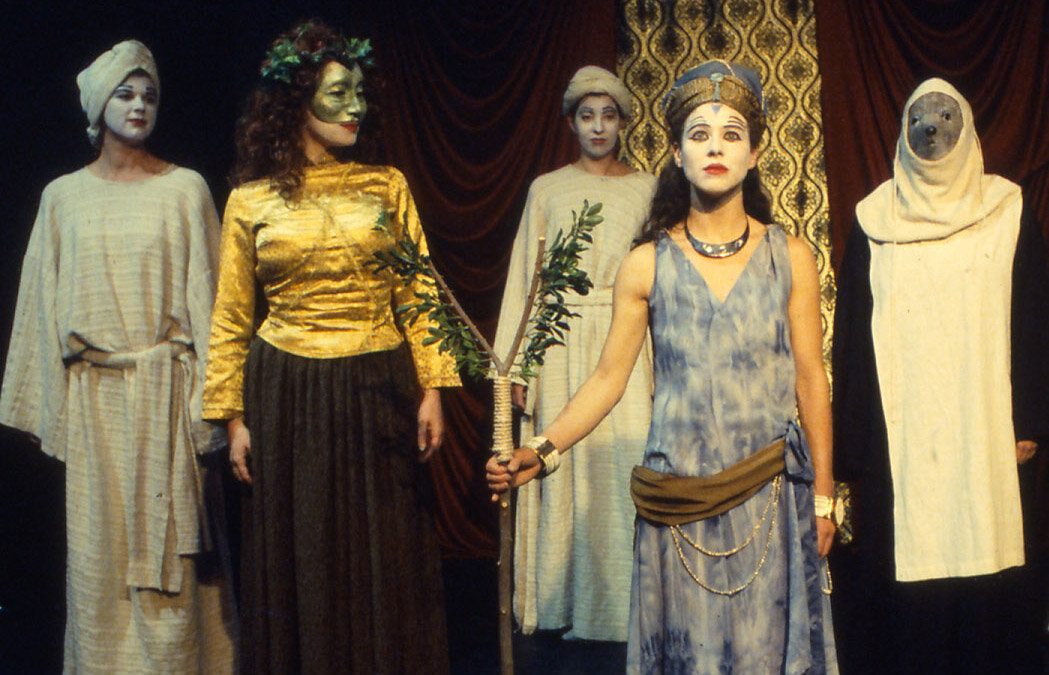Language and Theatre - Ninshaba
I spent four months in Poland watching dozens of plays in a language foreign to me (that would be Polish). As a result, I became fascinated with how information is conveyed on stage if you don’t have language to rely on. In fact, I became obsessed with it. (Especially after a five-hour production of Dostoevsky.) So I started writing plays in a language that is meant to be foreign to everybody.
And I wrote a lot of them.
Here are some lines of that language, which is written in iambic pentameter.
Catchy, right? There were 24 lines in all, and the lines and words did not correspond to a singular meaning. That is, we could use any word, sentence, or paragraph to mean whatever we wanted it to mean. And we could use the same sentence to mean one thing at one time, and another thing at another time. This was possible because, without meaning, the audience was not able to retain the individual words. Like sparrows that fly by, but don’t land. So once all 24 lines were learned, those lines could populate an entire script. But to be clear - the lines meant something to us.
I was lucky enough with work with very talented actors for several months at a time over several years to explore this, and we did a lot of experiments. Most prominently, asking the questions: “What information can (and cannot) be transmitted to an audience using a universal foreign language?” And “In what way is that information received?”
This is a different question than asking, “What information can be transmitted without speaking?”
All of these experiments involved actors speaking to each other. This was important. I did not want to create a piece of pantomime. I wanted to use language. Because, like life, I wanted to do plays where people talked to each other. Also by and large, I did not want to confound the audience.
There is a lot that you can’t convey without an understandable language. If fact, you can’t convey most things. You can’t tell someone your bundt cake recipe, for example. You can’t debate net neutrality. You can’t explain your theory of the Easter eggs in the Marvel movies. You might be able to convey, “Excuse me, your hair is on fire.” But you can’t convey “The atomic weight of nitrogen is 14.006amu, Buddy.”
Still, there are many things you can do. I did not want the audience to be lost. But I did want them to use their attention in a different way.
Street Scene 1
Consider this: You are in the middle of a city and a stranger, a woman, comes up to you and tells you that an accident has occurred on the next block and there is someone who needs help. You give her your attention and listen to her story. And, if need be, you go and offer help.
Street Scene 2
But now, consider this: You are in a foreign city and a stranger comes up to you with an emotional monologue, and you don’t understand a single word. You listen to her, yes. But now your attention is focused in a completely different way. You are not concentrating on the language. You are looking at the speaker for any clues as to what she is trying to convey. Has an accident occurred? Or is this about something else entirely? Is she hurt? Is she holding anything? How is she standing? Where is her focus? And a hundred other things that can’t be put into words. You are giving this speaker 10 times the attention that you gave the one who spoke to you in English. You are actively engaged in a completely new way.
This is what I wanted from my audience.
Brecht said that the spectator is always asleep. The spectator always thinks he knows what is going to happen. I wanted my audience awake. And I wanted the nucleus of their attention.
As of this writing, I have eight full-length plays that are either fully or partly written in this invented language, which we call Sambic Poetry. Some of those plays have been restaged and revised, as I tried to learn from my mistakes, which have piled up like bad pancakes.
Ninshaba, 1997. Left to right: Angela Backman (in mask), Candace Reid, and Dana Legawiec. Mask by Becky Kravetz. Costumes by Robert Velasquez.
The fourth “foreign language” play I wrote, and with the most complete use of Sambic Poetry, is called Ninshaba. It premiered as a Ziggurat Theatre Ensemble production in 1997 and we revived it in a new production in 2017 on its 20th anniversary.
Beckie Kravetz designed the masks used in both productions. For the 1997 production, the costume design was by Robert Velasquez. For the 2017 production, the costume design was by Anne Collins and the set design was by Stacey Koloski.
Ninshaba is a goddess story of my own creation, set in a pre-literate, fictionalized Middle-Eastern setting. It is about a girl, Ninshaba, who dreams in a fever that the mother she has never known is a queen, and lives on a far-off mountain. Ninshaba journeys across the desert and, after many trials, is united with her mother and discovers her own divinity.
Ninshaba 1997 - Candace Reid and Dana Legawiec (in mask)
Mask by Beckie Kravetz. Costumes by Robert Velasquez.
Ninshaba was created slightly accidentally. I had just moved to Los Angeles and put an ad in Backstage for actors who were interested in theatre and not TV or film. (An ad in the newspaper! That’s how we rolled in those days!) I cast eight actors and wrote a scenario which we would turn into a play. Then one actor dropped. My eight-actor idea wouldn’t work. So I wrote different scenario for seven actors. Then another one dropped. My seven-actor idea wouldn’t work. So I wrote a new scenario for six. Drop. And then five. Drop. Four. Drop. And now I had just three actors left, all women. I said, “If you all stay with this project, I promise you we will actually do a play.” I wrote three scenarios specifically for those actors, one of which was Ninshaba. The actors voted to work on that scenario and, God bless them, they developed and rehearsed it for six months.
Ninshaba 1997 - Left to right: Myrtle Wood, Dana Legawiec (in mask), Hep Jamieson, Candace Reid, and Angela Backman (in Mask.)
Masks by Beckie Kravetz. Costumes by Robert Velasquez.
Those three original actors rehearsed for four months and then we added three more actors, all women, to form a chorus and rehearsed for two more months.
The piece has eleven scenes and for every one of them we had to be specific about what we could convey and what we couldn’t. And we invited friends in during rehearsals and showed them scenes to make sure they could understand them. The first scene had to be the clearest. So the play started with Ninshaba in a fever being tended by her nurse. This is a scene which needs little language, as the situation of a sick person being cared for is universal.
Ninshaba 1997 - Angela Backman and Candace Reid
Costumes by Robert Velasquez.
We had a very tense production week for its premiere in Los Angeles, as the actors became concerned that the play wouldn’t be received as we intended it. That is probably true with every play, but more so here. And the play had a very exacting physical score created by Dana Legawiec, who was in the play, as well as its movement director. So the precision of the piece was crucial to its realization. Nerves were frayed as we got closer to the opening. One of the actors had an agent who was trying to get casting people in the TV/film industry to see her work. This was common for an LA actor in a play. The agent said to her, “Let me get this straight. You are doing a play in whiteface and masks, entirely in a foreign language. And I’m supposed to get the sitcom people to see it?”
But, the language issue aside, we were trying to say something with this play. The lack of English was a means to an end. It wasn’t about the language.
Ninshaba 1997 - Candace Reid and Dana Legawiec
Costumes by Robert Velasquez.
I gave a short introduction as part of the play where I said to the audience that what they would see would not be in English. You could feel the energy shift in the room when that bomb was dropped. After performances, I was told by more than one spectator that they became very worried when they heard this. More accurately, some said they wouldn’t have come if they had known it was in some crazy foreign language. But this did not end up being an issue. Once the play started and the audience realized that they could “understand” it, they were with us. The production was critically lauded, we sold out the run, and we had to extend.
Ninshaba 2017 - Kathleen Nation, Erica Murphy, and Molana Oei (in mask) Masks by Beckie Kravetz. Costumes by Anne Collins. Set by Stacey Koloski.
In 2017, on the 20th anniversary of its premiere, we restaged Ninshaba in Portland, Maine with an entirely new cast, except for Dana, who reprised her roles. Ninshaba was written about by poet Megan Grumbling, who was seeing the play for the first time. She said:
“The experience of watching immediately feels different. Gesture, costume, and sound become momentous and charged, become the crucial, archetypal currencies of the story…. Loosened in time, freed from verbal language, we watch with a different part of the brain, and it is exhilarating.”
Ninshaba 2017 - Left to Right: Emily Grotz (in mask), Holly Pryor, Megan Tripaldi, Erica Murphy, Kathleen Nation and Molana Oei (in mask)
Masks by Beckie Kravetz. Costumes by Anne Collins. Set by Stacey Koloski.










